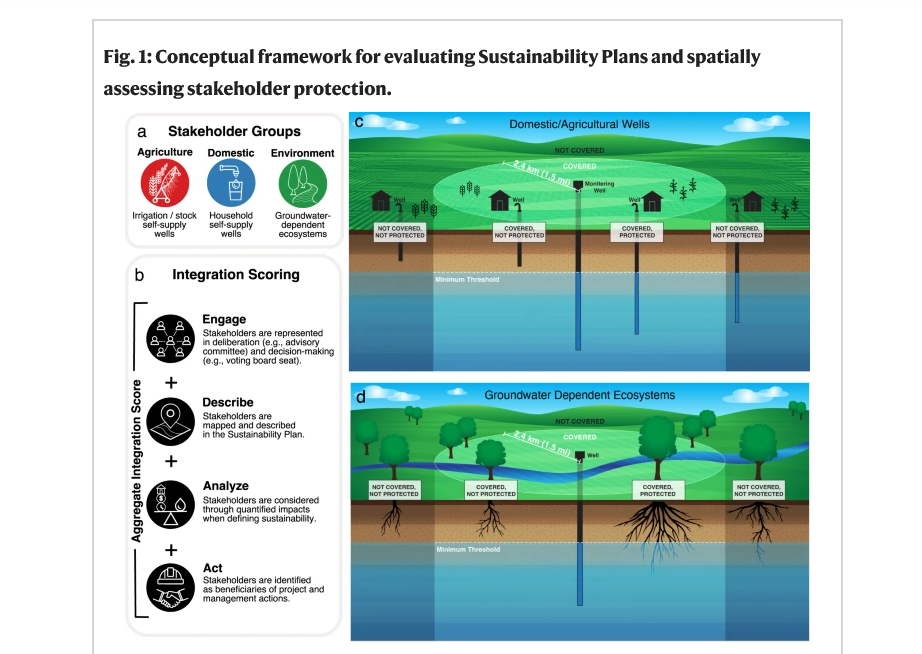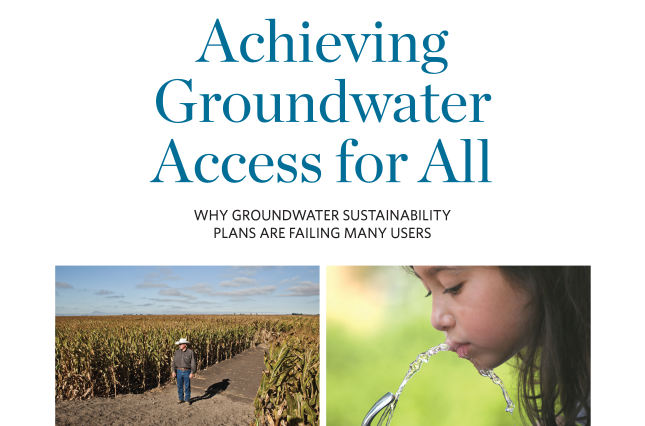
The Nature Conservancy, the Union of Concerned Scientists, Audubon California, and Clean Water Action suggest that without course correction, State’s Sustainable Groundwater Management Act will fall short of goals
SACRAMENTO, CA — A new report published this week, authored by experts from The Nature Conservancy, the Union of Concerned Scientists, Audubon California, and Clean Water Action, provides a new set of recommendations on how California’s Sustainable Groundwater Management Act can better protect vulnerable communities and the environment. The recommendations are based on findings from a study published this week in Nature Communications, which found that the majority of local groundwater plans developed under California’s Sustainable Groundwater Management Act (SGMA) overlook the state’s most vulnerable groundwater users.
More than 100 groundwater sustainability plans submitted to the State of California and required under SGMA in 2020 and 2022 were rigorously reviewed to assess the degree to which each plan integrates diverse stakeholder groups into the planning process.
A diversity of stakeholders rely on groundwater: drinking water users, disadvantaged communities, small and large farms, and California’s ecosystems. While SGMA calls for groundwater plans to be inclusive of these many stakeholders’ needs in planning for future sustainable water use, it is not prescriptive on how to achieve that goal.
Vulnerable groundwater users – such as those who rely on shallow drinking water or irrigation wells, and ecosystems that depend on groundwater – have much to lose if groundwater plans do not protect them. Yet, the publication found that these groups have been largely excluded from groundwater planning and decision-making.
The publication found:
- Less than 40% of groundwater plans integrate all stakeholder groups
- Only 9% of plans include a member of an underrepresented stakeholder group in decision-making bodies (such as a board or advisory council)
- Despite a SGMA requirement to do so, 25% of plans fail to fully identify disadvantaged communities
- Just 35% of plans explicitly consider negative impacts to domestic wells
- Only eight plans (out of 108) have a well-mitigation plan in place, meaning that most local agencies have no plan to address drying wells
- While 92% of plans identify groundwater-dependent ecosystems in their basins, just 9% of those ecosystems are protected from losing access to water
“Our new analysis of these plans reveals that most plans do not sufficiently integrate a majority of their stakeholders into the groundwater planning process, which creates a critical barrier for protecting them from groundwater depletion losing access to water,” said Melissa Rohde, a lead researcher for the report. “Our results show that when vulnerable groundwater users, such as domestic and environmental stakeholders, are better integrated into planning and decision making, they are also better protected by the plans.”
The report also finds that groundwater sustainability plans lack information about climate change impacts on water resources.
“To fight groundwater depletion we must ensure that the full range of users have a seat at the table,” said Caitrin Chappelle of The Nature Conservancy California Water Program. “California cannot get to sustainability if groundwater is managed primarily for a select group of users. Equity and representation are not only important from a societal perspective – they are also key to sustaining biodiversity and entire ecosystems.”
By quantifying how well each stakeholder group is protected by existing groundwater sustainability plans, the report concludes that large data gaps from insufficient groundwater monitoring increase the risk that unsustainable groundwater use will harm underrepresented communities and the environment.
SGMA is an historic opportunity for the state to protect our ecosystems and people from climate change impacts,” said J. Pablo Ortiz-Partida, senior climate and water scientist with the Union of Concerned Scientists. “However, for the law to be as effective as possible, local agencies need to include extreme climate scenarios and data into groundwater management plans, so that drinking water wells and ecosystems are less vulnerable to drought and low-lying farmworkers communities are protected from extreme flood events.”
“Across SGMA basins, disadvantaged communities continue to experience dry wells, yet most agencies do not have a drinking water well mitigation plan in place” said Ngodoo Atume, Senior Water Policy Analyst with Clean Water Action. “The Department must uphold the Human Right to Water and ensure that local agencies protect drinking water users reliant on shallow wells.’”
The report provides specific recommendations the State of California should implement to address these findings, in three areas:
- Leveraging state funding to increase stakeholder integration
- Updating and expanding SGMA guidance to groundwater agencies to ensure protection of vulnerable users
- Closing information gaps that are critical for tracking the impact of groundwater management on all users
“The passage of SGMA was critical for bringing California on par with other western states when it comes to requiring sustainable groundwater management,” said Xerónimo Castañeda, conservation project manager with the National Audubon Society. “To fulfill the promise of the law and protect rapidly shrinking habitats for birds and other wildlife, it’s critical that these groundwater plans incorporate a variety of stakeholders and take the environment, habitat and wildlife into account.”
# # #
Clean Water Action is a national nonprofit founded in 1972 to promote citizen engagement and action to protect our environment, health, economic well-being and community quality of life. Clean Water Action organizes strong grassroots groups, coalitions and campaigns to solve environmental and community problems.
The Nature Conservancy is a global conservation organization dedicated to conserving the lands and waters on which all life depends. Guided by science, we create innovative, on-the-ground solutions to our world's toughest challenges so that nature and people can thrive together. We are tackling climate change, conserving lands, waters and oceans at an unprecedented scale, providing food and water sustainably and helping make cities more sustainable. Working in 72 countries, we use a collaborative approach that engages local communities, governments, the private sector, and other partners.
The Union of Concerned Scientists is a national nonprofit organization founded more than 50 years ago by scientists and students at the Massachusetts Institute of Technology. Our mission: to use rigorous, independent science to solve our planet's most pressing problems. Joining with people across the country, we combine technical analysis and effective advocacy to create innovative, practical solutions for a healthy, safe, and sustainable future.
The National Audubon Society protects birds and the places they need, today and tomorrow. Audubon works throughout the Americas using science, advocacy, education, and on-the-ground conservation. State programs, nature centers, chapters, and partners give Audubon an unparalleled wingspan that reaches millions of people each year to inform, inspire, and unite diverse communities in conservation action. A nonprofit conservation organization since 1905, Audubon believes in a world in which people and wildlife thrive.
